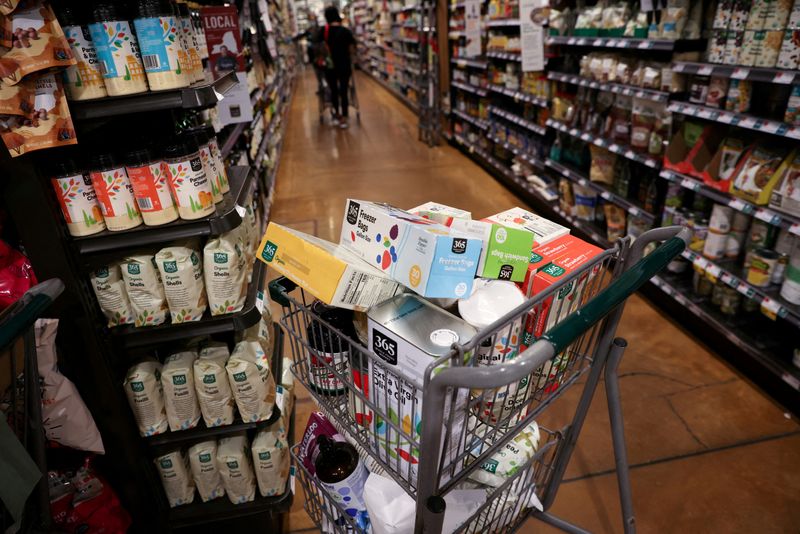By Francesco Canepa
(Reuters) - Calling the top of the current wave of inflation has been a painful exercise for economists and central bankers, who have been proven wrong time and again over the past year.
But data on Wednesday, which showed that some measures of inflation had cooled in the world's two largest economies, was likely to rekindle a debate about whether the worst might be over after a year of torrid price growth.
U.S. consumer prices did not rise in July from the month before due to a sharp drop in the cost of gasoline, delivering the first notable sign of relief for Americans who have watched inflation climb over the past two years.
And China's factory-gate inflation slowed to a 17-month low on an annual basis while consumer prices rose less than expected.
After wrongly predicting last year that high inflation would be transitory, most central bankers have stopped trying to put an exact date on when they expect current price growth to peak.
But Federal Reserve officials see inflation decelerating through the second half of the year, the European Central Bank puts the peak in the third quarter and the Bank of England sees it in October.
Here are some of the key data shaping the inflation debate:
RAW MATERIALS ARE GETTING CHEAPER...
The main culprit for the surge in consumer prices last winter - energy and other raw materials - may be the harbinger of lower inflation this time around.
Prices of many key commodities such as oil, wheat and copper have fallen in recent months, with a Refinitiv index spanning crude oil to orange juice down nearly 20% from its May peak.
The fall mostly mirrors weaker global demand amid economic downturns from China to the United States and Europe, where consumers are struggling to cope with the high prices.
This is already having an impact on some measures on inflation: the share of manufacturers reporting rising input costs is shrinking and growth in wholesale prices is slowing across much of the world.
This should eventually filter through to consumer inflation.
GRAPHIC: The price of raw materials has eased back a little (https://fingfx.thomsonreuters.com/gfx/mkt/zdvxoznbapx/The%20price%20of%20raw%20materials%20has%20eased%20back%20a%20little.png)
...BUT EUROPEAN ENERGY BILLS WON'T
European households are unlikely to see their energy bills come down anytime soon, however, and there's increasing talk of rationing in countries including in Germany.
This is because gas prices in Europe, which has for years relied on Russia for a large portion of its imports, are still four times higher now than a year ago and close to record highs.
Even in Britain, which has its own gas but very little storage capacity, consumers are set to see their power bills jump in October when the current price cap expires.
There's bad news for German drivers too, who will see a subsidy at the petrol pump expire at the end of August.
GRAPHIC: European gas prices have gone up fourfold in one year (https://fingfx.thomsonreuters.com/gfx/mkt/gdvzyodljpw/European%20gas%20prices%20have%20gone%20up%20fourfold%20in%20one%20year.png)
EXPECTATIONS ARE (MOSTLY) UNDER CONTROL
Some central bankers can take comfort in the fact that investors haven't lost faith in them.
Market-based measures of inflation expectations in the United States and the euro zone are only just above the central banks' 2% target, while they remain uncomfortably high in Britain.
Even the message from households, who are slower than markets in reacting to changes and tend to overestimate inflation, is not one of panic.
Consumers polled by central banks in the United States, euro zone and Britain see inflation above 2% for several years to come - but not much higher than 3% at most.
The vast majority of economists in a global Reuters poll also said it would be at least next year before the crisis recedes significantly, while 39% thought it would take longer than that. [ECILT/WRAP]
GRAPHIC: Inflation expectations are mostly under control (https://fingfx.thomsonreuters.com/gfx/mkt/jnvwenxdrvw/Inflation%20expectations%20are%20mostly%20under%20control.png)
CORE PRICES MAY BE TRENDING DOWN...
Measures of inflation that strip out energy and food prices have already started to fall in the United States and Britain, and some predict Japan and the euro zone will follow suit.
Core inflation remains well above central banks' comfort zone across developed and developing economies, meaning that further policy tightening is needed.
But the latest slowdown in the United States and Britain showed the recent interest rate hikes were already having some effects.
And an artificial intelligence model used by Oxford Economics suggests core inflation will also peak in Japan and the euro zone in the second half of the year.
The Long Short-Term Memory network, originally developed to help machines learn human languages, parses detailed inflation data to spot patterns that helps it predict the Consumer Price Index in the future.
GRAPHIC: Core inflation seems to have peaked (https://fingfx.thomsonreuters.com/gfx/mkt/byvrjykgdve/Pasted%20image%201660137870455.png)
... BUT WAGES ARE POINTING UP
Workers' wages have far from caught up with the increase in prices over the last year but they are at least regaining some ground.
Unit labour cost, or the cost of labour for every unit of output, grew by almost 10% for non-farm businesses in the United States in the second quarter of this year, data showed earlier this week.
Wages are one of the most important drivers of prices in the long term and, if they rise too fast, they may initiate a vicious circle of price increases.

But outside the United States, the rebound has been more modest and the upcoming recession may well weaken labour's hand in pay negotiations.
GRAPHIC: U.S. wages are pointing up (https://fingfx.thomsonreuters.com/gfx/mkt/akvezkmwlpr/U.S.%20wages%20are%20pointing%20up.png)